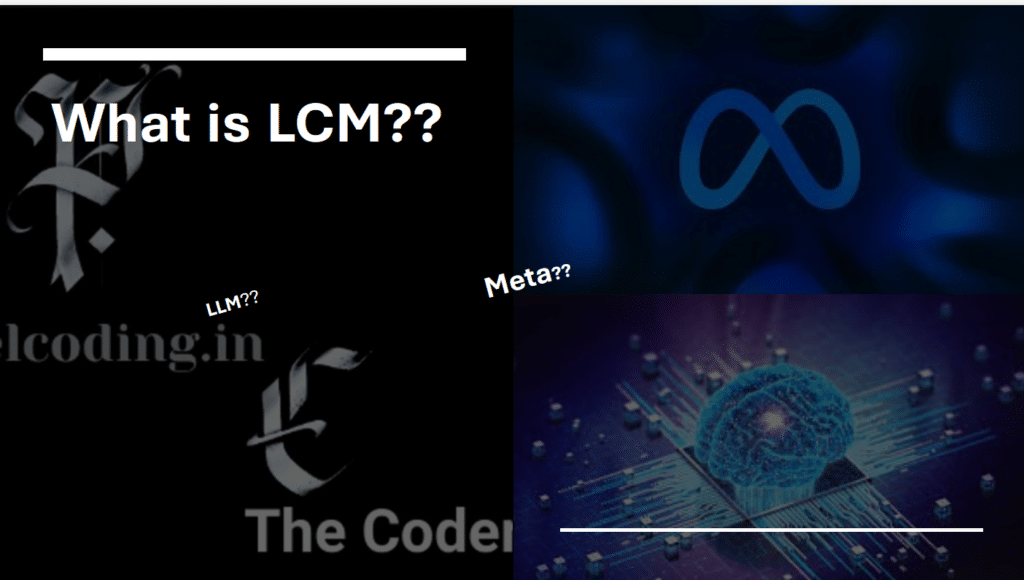In this blog let us understand what do you mean by LCM and what are the applications of LCM?
Hello again let us start with the first question what is the abbreviation by LCM?
It is not the LCM we have learnt in our schools it is abbreviated as Large Concept Model.

Now let us move to the next question what do you mean by LCM?
Unlike LLM which have revolutionized and process output to the user input at token level, in simple words LLM tries to understand the user response and generate the content.

Meta tried to attempt an architecture which operates on an explicit higher-level semantic representation, which they named it a “concept”.
Concepts are language- and modality-agnostic and represent a higher level idea or action in a flow, in simpler words Hence, they build a“Large Concept Model”.
Let me break down the above context into simple words:
Imagine you are building with Lego blocks. Typically, you construct small sections one at a time and then assemble them to create a complete building.
Now, picture a different model where all the sections are already pre-built, and your only task is to assemble them according to your needs.
Let’s break down these two scenarios:
In the first case, it resembles how traditional Large Language Models (LLMs) work — you build the product word by word, assembling meaning piece by piece.
In the second case, it reflects how Large Concept Models (LCMs) operate — you have complete, pre-built concepts, and your task is simply to arrange them based on the requirements.
What are these two terms language- and modality-agnostic?
Imagine you have a pre-built kitchen model. No matter what language you use — whether it’s English, Spanish, or German — it’s still a kitchen. The idea stays the same, which is what we mean by language-agnostic.
In simple words:
Language-agnostic: The idea remains the same, no matter which language you use.
Now, think about that same kitchen model. Whether you talk about it, write about it, or show it in a picture, it’s still recognized as a kitchen. The concept doesn’t change — and that’s what we mean by modality-agnostic.
Modality-agnostic: The idea can be in text, speech, or even image form — it’s still the same concept.
Now let us dive into the details of LCM:
LCM’s utilize SONAR, a multilingual and multi modal sentence embedding space that supports over 200 languages in both text and speech modalities. By operating in this embedding space, LCM’s can perform auto regressive sentence prediction, generating sequences of sentence embedding that can be decoded back into natural language.
How Do LCMs Work?
- Sentence Embedding: It is the numerical representation of the sentence to capture the original meaning and context of the sentence. Now input text is broken down into sentences, where each of it is embedded into SONAR space, which produces sequence level sentence embedding.
- Sequence Modeling: It is the ability of a program to understand, interpret, predict, or generate data that unfolds over time. The LCM processes this sequence to predict subsequent sentence embedding, effectively modeling the progression of ideas or concepts.
- Decoding: It is a stage where the idea is unfolded into the original idea. The predicted embedding are then decoded back into natural language sentences using a decoder trained to map embedding to text.
This methodology allows LCMs to generate text that is semantically coherent and contextually appropriate, even across multiple languages and modalities.
Applications of LCM:
Text Generation
LCMs can generate longer texts (stories, articles, summaries) because they think in ideas, not just predicting the next word.
Example: Writing blog posts, books.
Education and E-Learning
LCMs can create concept-based learning materials that explain ideas rather than just listing information.
Example: Auto-generating lesson plans, concept summaries, quizzes, etc.
In conclusion LCM is a promising new idea, but it’s not yet production-ready like GPT-4, Gemini, Claude, etc.
It’s an emerging technology with a lot of exciting potential, but also many open challenges researchers are still solving.
If you like the blog do share it with your friends thank you.